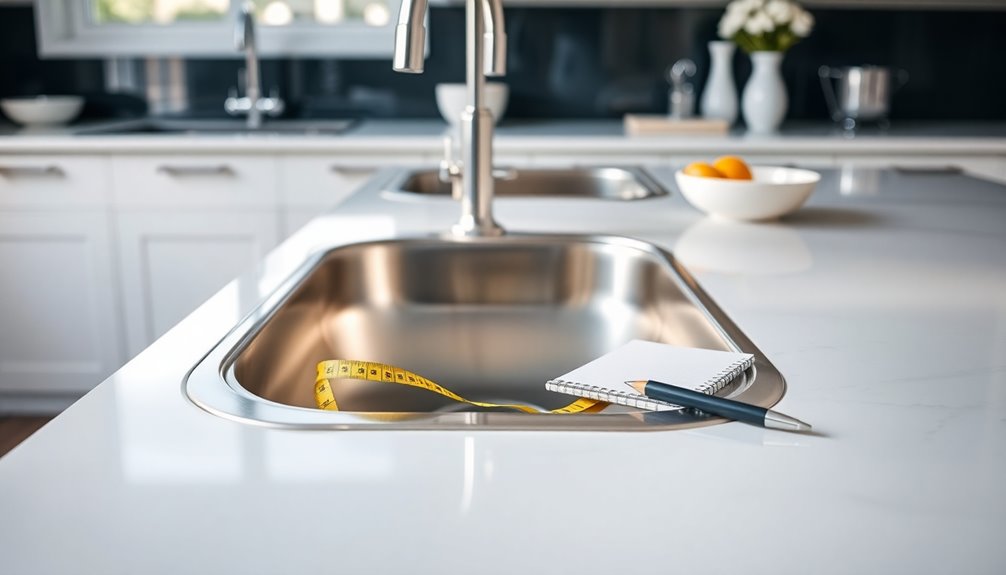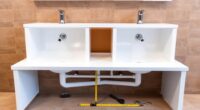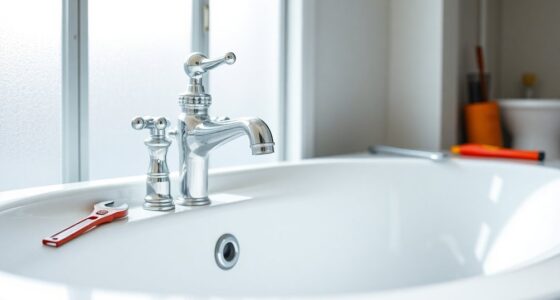To measure for a sink grid, grab a measuring tape and measure the width and depth of your sink. Then, measure the distance from each side of the sink to the drain center. Don't forget to note the corner radius for compatibility. Create a cardboard template based on these measurements, adding 1/2 inch for a snug fit. This approach helps you find the right grid. Keep going to discover more helpful tips and tricks!
Key Takeaways
- Use a measuring tape to find the sink's width and depth, ensuring accurate dimensions for the grid fitting.
- Measure the distance from each side of the sink to the drain center for proper alignment.
- Note the corner radius of the sink to match with the grid's curvature.
- Create a cardboard template from your measurements, adjusting it to be 1/2 inch larger than the grid dimensions.
- Record all measurements and check manufacturer specifications for compatible grid sizes.
Importance of Accurate Measurements
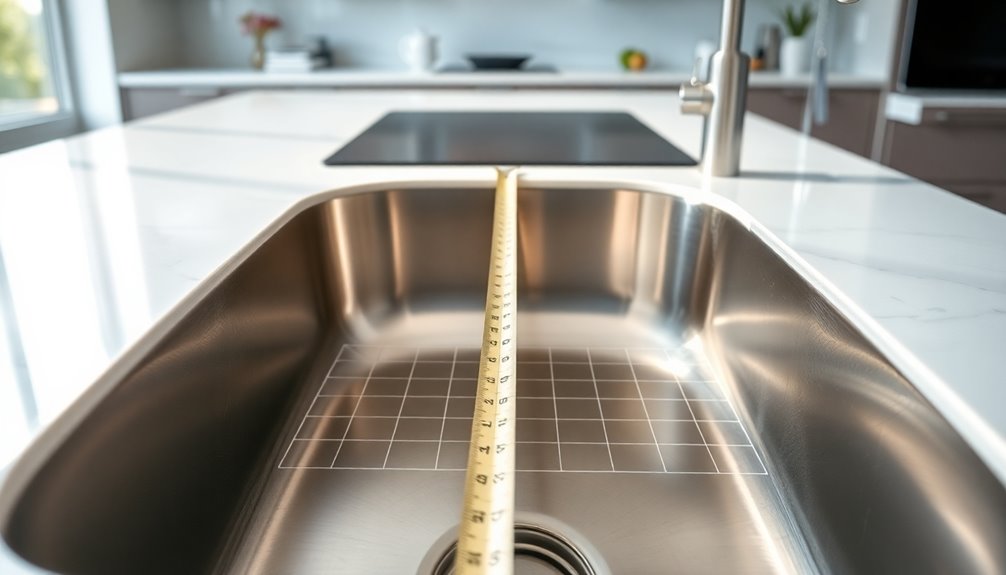
Accurate measurements are essential when fitting a sink grid, as even slight discrepancies can lead to improper installation.
To achieve a perfect fit for your kitchen sink, you need six specific dimensions: width, depth, and the distances from the front, back, and both sides to the drain center.
Pay special attention to the drain hole's location and guarantee the radius of the sink corners matches the grid's corner radius.
A well-fitted sink grid prevents damage and enhances the sink's functionality by covering the entire bottom surface.
Taking the time to measure accurately simplifies your shopping experience for compatible grids, reducing the likelihood of returns or exchanges.
Prioritize these measurements for a seamless installation and peak performance.
Step-by-Step Measurement Guide

Measuring for a sink grid is a straightforward task that guarantees a perfect fit and excellent functionality. Start by using a tape measure to find the width across the top, just above the curve of the sink. Next, measure the depth from front to back. Record these measurements and take four additional measurements from each side of the sink to the center of the drain hole. Don't forget to note the curvature of the corners, as stainless steel grids need to match these for maximum compatibility.
| Measurement Type | Measurement Location | Notes |
|---|---|---|
| Width | Side of the sink | Just above the curve |
| Depth | Front to back | Same point as width |
| Drain Hole Distance | Each side to center | Confirm accuracy |
| Corner Radius | Sink corners | Match grid corner radius |
Creating a Cardboard Template

To create a cardboard template for your sink grid, you'll need a few basic materials like cardboard, a ruler, and a pencil.
Start by measuring your sink's dimensions and then cut the cardboard to size, tracing the corners for accuracy.
This template not only helps you visualize the fit but also guarantees that your grid aligns perfectly with the sink's features.
Template Materials Needed
Creating a cardboard template for your sink grid is a straightforward process that can substantially improve your chances of finding the right fit.
To get started, you'll need a piece of cardboard larger than your sink's dimensions. This guarantees you capture the entire area accurately. Cut the cardboard to closely match the width and depth of your sink, then trace the sink's outline onto it.
Don't forget to account for the curvature of the corners; use a round object to trace them precisely. Once you've cut out your template, place it in the sink to check the fit.
This template will help you compare against potential sink grids, ensuring they match perfectly in width, depth, and corner radius.
Steps to Create
Once you gather your materials, start by cutting a piece of cardboard that's larger than the sink's dimensions.
Next, accurately trace the outline of the sink onto the cardboard, making sure to include the curvature of the corners, typically around 3 1/2 inches.
After that, create cutouts in the cardboard to represent the drain hole location, ensuring a precise fit.
Measure the width and depth of the sink, adjusting the template to be 1/2 inch larger than the grid dimensions. This extra space allows for a perfect fit when you place the grid inside.
Finally, take the cardboard template with you when shopping, so you can easily compare it against available sink grids for compatibility.
Benefits of Templates
Using a cardboard template offers several advantages that can greatly enhance your sink grid shopping experience.
First, it provides a physical representation of your sink's dimensions, helping you visualize how the grid will fit before you buy. You can make precise adjustments, ensuring all measurements accommodate the curvature or radius of the sink corners.
Plus, a template allows you to double-check your measurements against the actual sink shape, reducing the chances of mistakes. It also helps you test grid placement and spacing, ensuring the drain hole aligns perfectly with the sink's center.
Selecting the Right Sink Grid

When you're selecting a sink grid, focus on choosing durable materials to guarantee it lasts.
Check the manufacturer specifications to find a grid that fits your sink perfectly.
This way, you'll avoid any issues down the line and keep your sink looking great.
Choose Durable Materials
Choosing durable materials for your sink grid is essential for ensuring long-lasting performance and protection. Opt for 304 premium stainless steel, as it offers rust-free performance and durability.
Make sure the grid has a heavy-duty design, with an outer wire diameter of at least 1/4 inch and an inner wire diameter of 1/8 inch to enhance stability. Look for metallic grids that include rubber feet; these prevent scratches on your sink's surface while keeping the grid securely in place.
A well-constructed sink grid not only safeguards your sink but also boosts the longevity of both the grid and the sink itself. Prioritizing durability now will save you time and money in the long run.
Check Manufacturer Specifications
Selecting the right sink grid starts with checking manufacturer specifications, as these details guarantee a perfect fit for your sink.
First, look for the manufacturer's name on your sink, which can provide specific size recommendations for compatible grids. If you can't find this name, take precise measurements of your sink dimensions.
Make certain the grid's corner radius matches the curvature of your sink corners for superior compatibility. Additionally, choose durable grids made from corrosion-resistant materials like 304 premium stainless steel to guarantee longevity.
Finally, verify that the grid dimensions are approximately 1/2 inch smaller than your sink's length and width, allowing for a snug fit that accommodates any curvature. This attention to detail will enhance your kitchen's functionality.
Benefits of Using a Sink Grid

A sink grid is an invaluable addition to your kitchen, offering multiple benefits that enhance both functionality and longevity.
First, it protects your sink surface from scratches and damage, extending its lifespan by minimizing wear from daily use. You'll also find that it safeguards your delicate china and glassware, reducing the risk of breakage while washing and drying dishes.
The grid provides a stable surface for drying utensils and dishes, promoting an organized workspace. Plus, a well-fitted sink grid helps prevent food debris from accumulating, making cleanup a breeze.
Durable options made from high-quality materials, like 304 premium stainless steel, resist corrosion and guarantee your grid lasts through the rigors of daily kitchen activity. Moreover, investing in high-quality materials is essential for ensuring the longevity of modern toilets, just as it is for sink grids, as it significantly contributes to their overall durability and performance.
Common Measurement Mistakes to Avoid

Installing a sink grid can greatly enhance your kitchen experience, but it's important to get the measurements right to guarantee a proper fit. One common mistake is failing to measure the sink's width and depth accurately; always double-check each dimension with a tape measure.
Additionally, measuring from different points above the sink curve can lead to inconsistent results, so stick to one reference point. Don't overlook the radius of the sink corners, as this could cause gaps with the grid.
Also, be sure to account for the drain location; misalignment here can hinder functionality. Finally, creating a cardboard template helps visualize the grid dimensions and can prevent errors before you make a purchase.
Additional Resources for Sink Grid Selection
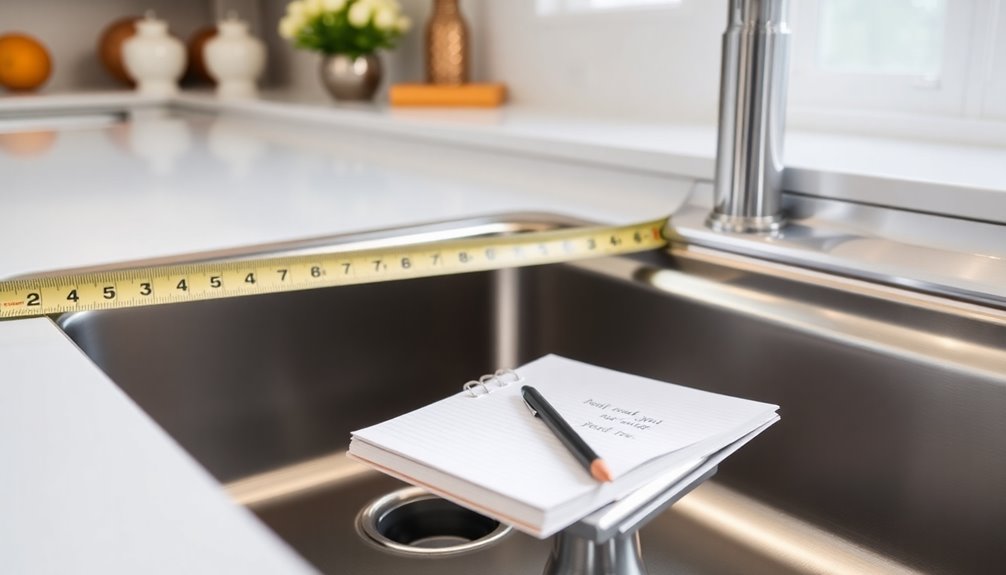
When you're ready to choose the perfect sink grid, a wealth of resources can help simplify the process.
Start by exploring dedicated online support from Sinkology, where you can get prompt answers to your questions.
You can also check out various design ideas on social media, which can boost your confidence in your choices.
Consider using the Grid-Finder tool on their website to match grids with your specific sink.
Here's a quick list of resources to enhance your selection process:
- Social Media Inspiration: Follow hashtags like #showusyoursink for community ideas.
- Grid-Finder Tool: Easily find compatible sink grids.
- Material Guidance: Discover specific sink types and accessory tips for functionality.
These tools can make your selection journey much smoother!
Customer Support and Assistance

How can you guarantee that you get the most out of your sink grid selection? By taking advantage of the dedicated Sinkologists team, you'll have access to expert assistance for any questions you might have.
Their online support typically responds within 12 hours, ensuring you get the information you need quickly. You can reach out through direct inquiries or connect on social media for additional help.
They also provide valuable resources to help you find specific sink types, like copper or fireclay, along with design tips.
This customer support team is committed to your satisfaction, emphasizing community engagement and knowledge sharing.
Don't hesitate to utilize these resources for a seamless sink grid selection experience.
Frequently Asked Questions
How Do You Measure a Sink Grid?
To measure a sink grid, you'll want to start by determining the sink's dimensions accurately.
Measure the width from side to side, just above the sink's curve, and the depth from the front to the back at the same point.
Don't forget to take additional measurements from the front and back to the drain center, and the sides to the drain center.
These details will help you find the perfect fitting grid.
How to Measure for Sink Insert?
Imagine the perfect sink insert, fitting snugly like a puzzle piece. To measure for it, grab a tape measure and check the width from side to side at the sink's top edge.
Then, measure the depth from front to back. Don't forget to note the drain's position—it's key for a seamless fit.
How Do You Measure the Radius of a Sink Corner?
To measure the radius of a sink corner, grab a flexible measuring tape or ruler.
Start at the center of the corner curve and measure to the edge of the sink. For accuracy, place a straight edge against the sink's edge and measure from this line to the inner edge of the curve.
If the curve's consistent, check multiple points along it. You can also trace the corner on cardboard for a template.
How to Measure Sink Supply Line?
To measure your sink supply line, start by identifying its type—flexible, rigid, or braided.
Grab a tape measure and find the length from the shut-off valve to the sink faucet connection, making sure it's straight.
Next, measure the diameter of the fittings, usually 3/8 inch or 1/2 inch.
Finally, check the distance between the faucet and supply connections, noting any obstacles that might affect installation.
This'll help guarantee a perfect fit!
Conclusion
In summary, taking accurate measurements for your sink grid is essential for a perfect fit and ideal functionality. Did you know that nearly 30% of homeowners end up with ill-fitting sink grids due to measurement errors? By following our step-by-step guide and avoiding common mistakes, you can be part of the successful majority. Invest a little time in measuring right, and you'll enjoy the benefits of a well-fitted sink grid for years to come!
